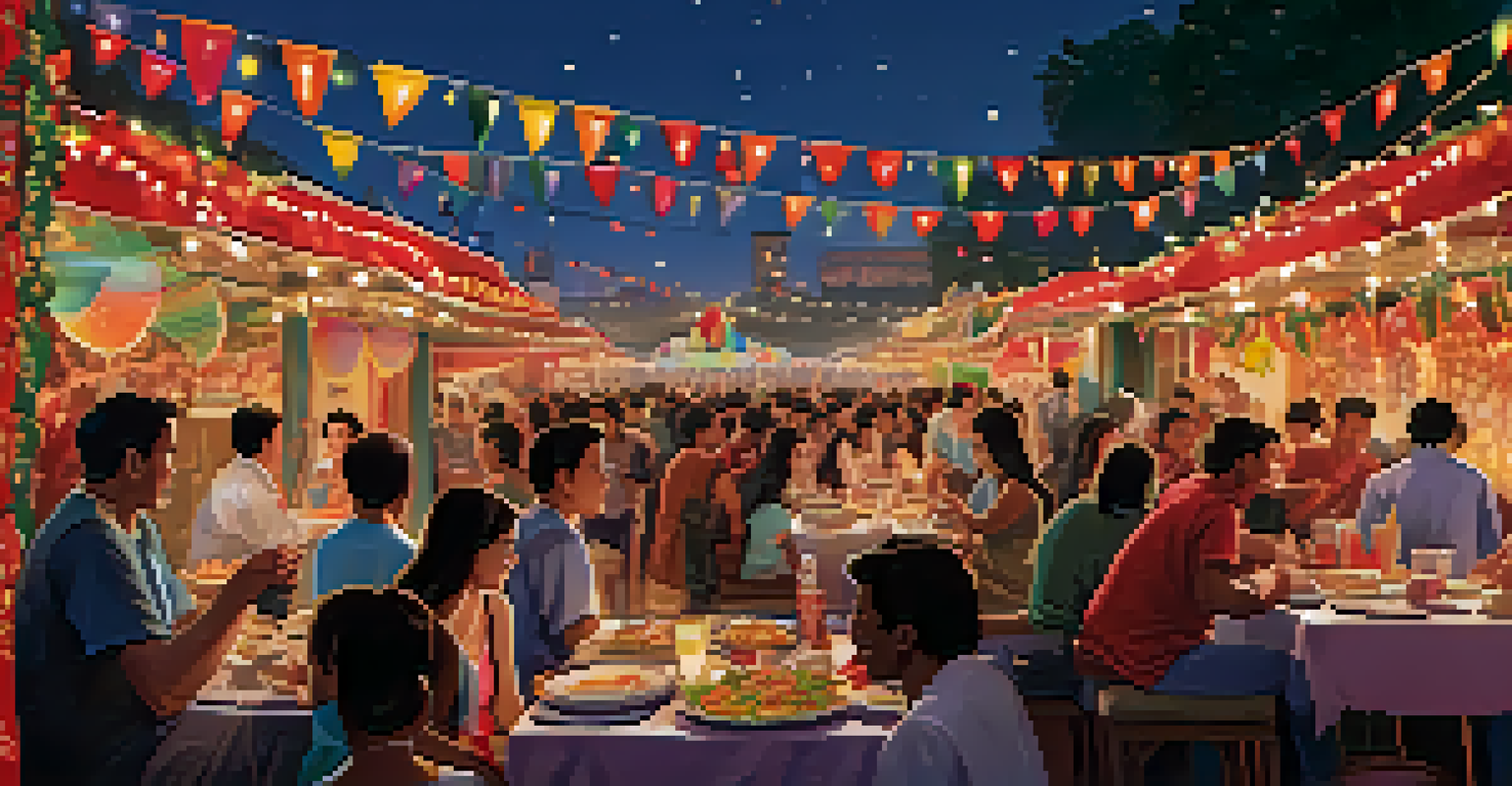Globalization of Cinema: Merging Eastern and Western Styles

Understanding the Impact of Globalization on Cinema
Globalization has created a seamless exchange of ideas and cultures, profoundly impacting cinema worldwide. As filmmakers and audiences connect across borders, unique storytelling elements from different cultures blend together. This fusion not only broadens the appeal of films but also enriches narratives by incorporating diverse perspectives.
Cinema is a matter of what's in the frame and what's out of it.
For instance, a Bollywood musical may incorporate Hollywood-style action sequences, creating an electrifying experience for viewers. These cross-cultural elements lead to innovative storytelling techniques that captivate audiences in ways traditional cinema could not. By embracing globalization, filmmakers can craft stories that resonate on a universal level, appealing to a broader audience.
However, this blending of styles can sometimes lead to cultural homogenization, where distinct cultural identities might be overshadowed. It's essential for filmmakers to find a balance between adopting global trends and maintaining their unique cultural narratives. This delicate dance is what makes the globalization of cinema both exciting and complex.
The Rise of Co-Productions: Bridging Cultures
Co-productions have become a popular way to merge Eastern and Western cinematic styles, allowing filmmakers from different regions to collaborate. These partnerships not only pool resources but also facilitate cultural exchange, leading to films that reflect a blend of influences. For example, films like 'The Great Wall' showcase a collaboration between Chinese and American filmmakers, merging storytelling techniques and visual styles.

Such collaborations can create a richer cinematic experience, as filmmakers draw on each other's strengths. By combining Eastern visual aesthetics with Western narrative structures, co-productions can appeal to diverse audiences. This approach not only enhances the storytelling but also provides a platform for cultural dialogue and understanding.
Globalization Enriches Storytelling
The blending of diverse cultural elements in cinema broadens narratives and appeals to a wider audience.
Moreover, co-productions can help smaller film industries gain international recognition. By partnering with established studios, filmmakers can reach wider audiences and gain access to better distribution channels. This practice underscores the importance of collaboration in an increasingly globalized film industry.
Cinematic Techniques: Blending Storytelling Styles
Eastern and Western cinema often employ different storytelling techniques, and globalization has encouraged filmmakers to experiment with these styles. Western films tend to focus on linear narratives and character-driven plots, while Eastern cinema often embraces non-linear storytelling and rich symbolism. This blending invites filmmakers to explore new ways of relating their stories.
The cinema is a mirror of the world, and it reflects the diversity of cultures and experiences that shape our lives.
Take, for example, the film 'Crouching Tiger, Hidden Dragon,' which combines Western action sequences with Eastern philosophical undertones. This melding of styles not only creates a visually stunning film but also offers deeper layers of meaning. By integrating these diverse techniques, filmmakers can craft narratives that are both entertaining and thought-provoking.
Such experimentation can challenge audiences' expectations and encourage them to embrace different ways of storytelling. As viewers become more exposed to these hybrid styles, they may find themselves appreciating the nuances of both Eastern and Western cinema. This ongoing exploration serves as a reminder of the beauty found in cultural diversity.
Character Archetypes: A Blend of Cultures
Character archetypes in cinema often reflect cultural values, and as films merge Eastern and Western styles, these archetypes evolve. For example, the 'hero's journey' is a common theme in both cultures, but the way it is portrayed can differ significantly. By blending these archetypes, filmmakers can create complex characters that resonate with a global audience.
A great example of this is found in the film 'The Matrix,' which infuses Western sci-fi elements with Eastern philosophical concepts, such as the idea of destiny and enlightenment. The characters embody traits that appeal to both cultures, allowing viewers from different backgrounds to connect with their struggles and triumphs. This fusion of archetypes not only enriches character development but also fosters a greater understanding of cultural narratives.
Co-Productions Foster Cultural Exchange
Collaborative films between Eastern and Western filmmakers create richer cinematic experiences and promote understanding.
Furthermore, the evolution of character archetypes invites audiences to see themselves reflected in diverse stories. As viewers engage with these complex characters, they may find new perspectives and insights into their own lives. This interplay of cultural influences enhances the cinematic experience, making it more relatable and engaging.
Cultural Representation: Celebrating Diversity in Film
In a globalized cinema landscape, cultural representation has emerged as a crucial topic. As Eastern and Western styles blend, it's essential that filmmakers accurately depict the cultures they represent. This commitment to authenticity not only honors the source material but also enriches the storytelling experience.
Films like 'Parasite' have garnered international acclaim by showcasing specific cultural dynamics while appealing to universal themes. This approach highlights the importance of diverse voices in cinema, allowing audiences to experience stories that reflect the complexities of different cultures. By prioritizing representation, filmmakers can create narratives that resonate with varied audiences around the world.
Moreover, cultural representation can challenge stereotypes and promote understanding among diverse groups. As audiences engage with authentic portrayals, they may develop empathy and appreciation for cultures different from their own. This shift in perspective is vital in an increasingly interconnected world, making cultural representation a key aspect of the globalization of cinema.
Audience Reception: Embracing Cultural Fusion
The fusion of Eastern and Western cinematic styles has led to a diverse range of audience receptions. Many viewers are excited to see different cultural influences come together, as it opens up new possibilities for storytelling. This excitement can be seen in the success of films that embrace this trend, drawing in audiences from various backgrounds.
However, not all viewers respond positively to this blending of styles. Some may feel that cultural elements are misrepresented or diluted in the process. This highlights the importance of thoughtful filmmaking that respects and honors the source material while appealing to a global audience. Filmmakers must navigate this complex landscape with care to ensure their work resonates authentically.
Cultural Representation Matters
Authentic portrayals of cultures in film are crucial for challenging stereotypes and fostering empathy among diverse audiences.
Ultimately, audience reception plays a crucial role in the success of these hybrid films. As viewers increasingly seek diverse narratives, the demand for culturally fused cinema will likely continue to grow. This evolving landscape presents an exciting opportunity for filmmakers to explore new creative avenues while fostering cross-cultural understanding.
The Future of Cinema: Embracing Global Influences
As globalization continues to shape the film industry, the future of cinema looks bright and diverse. Filmmakers are increasingly embracing global influences, leading to innovative storytelling that transcends cultural boundaries. This trend promises to enrich the cinematic experience, offering audiences a broader palette of narratives and styles.
Emerging technologies, such as streaming platforms, have made it easier for films from various cultures to reach international audiences. This accessibility allows viewers to explore different genres and storytelling techniques, fostering a greater appreciation for cultural diversity. As more people engage with global cinema, the demand for hybrid films will likely increase, encouraging filmmakers to experiment further.

However, it's important to remain vigilant about preserving cultural identities amid this globalization. Filmmakers should strive for authenticity while exploring new creative horizons, ensuring that the richness of diverse cultures is celebrated. By embracing these challenges, the future of cinema can continue to thrive as a vibrant tapestry of global storytelling.